The Best 7-Day Healthy Meal Plan, Created by a Dietitian
We map out the meals for you in this healthy eating plan. Follow along for a week of delicious meals and snacks.
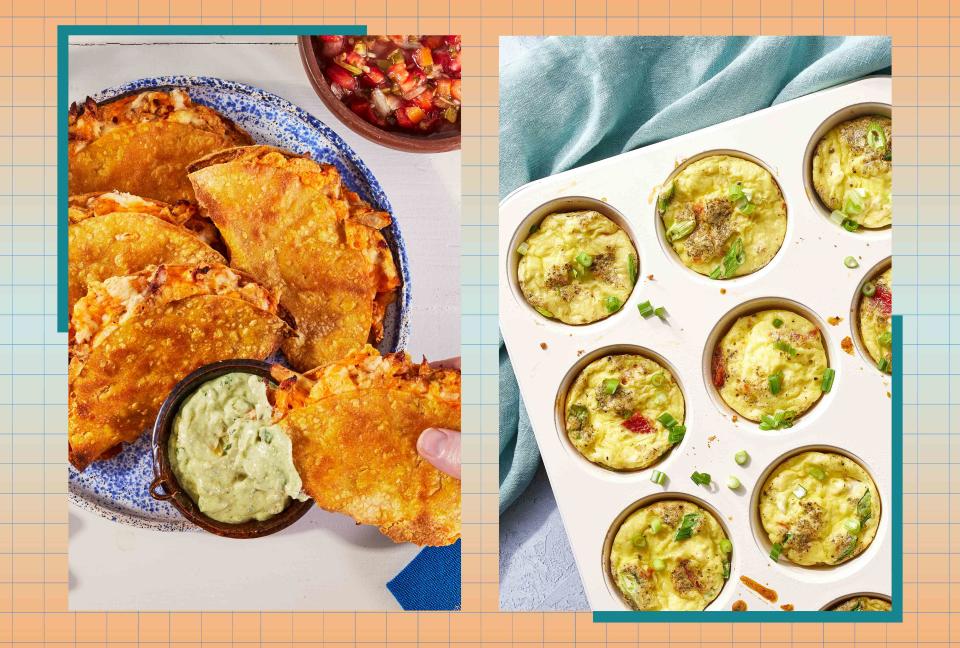
EatingWell
Reviewed by Dietitian Jessica Ball, M.S., RD
Looking for a delicious nutrient-rich meal plan? Look no further. We do the planning for you by mapping out an entire week of delicious meals and snacks. Cooking more meals at home has long been touted as a great money-saving strategy, but it can bring many health benefits, too. That said, we definitely understand that convenience is key, so we aimed to facilitate a smooth routine by including some meal-prep tips at the beginning of the week to ease some prep as the days go on. To up the nutrients and help you feel your best, you’ll find a variety of protein sources, veggie-forward meals, fruit, whole grains and gut-healthy fermented dairy, like yogurt and kefir.
Related: The Best Ingredients to Help Save You Time in the Kitchen, According to a Dietitian
We set this plan at 2,000 calories per day, which is what the Department of Agriculture lists as the estimated average calorie requirement for people age 14 and older. Because 2,000 calories is the commonly accepted average calorie requirement, it’s also used on the nutrition label to calculate percent Daily Values of the nutrients listed. Individual calorie requirements do vary, however, based on factors like muscle mass, exercise, age and body size. To accommodate different needs, we provide calorie modifications for 1,800 and 2,200 calories per day, but further adjustments may be required based on your individual nutrient and energy needs. As with all meal plans, this is meant to serve as a template for a healthy eating routine. Feel free to make adjustments to better fit your lifestyle, such as swapping meal or snack options or opting for leftovers.
Fiber: A Nutrient of Concern
Fiber is an important nutrient with many health benefits, including improved digestion, blood sugar levels and heart health. Plus, fiber has staying power, meaning foods rich in fiber help us stay full between meals. Unfortunately, many of us are falling short of our daily fiber intake, with just 7% of Americans reaching their daily fiber goals. As a result, the 2020-2025 Dietary Guidelines for Americans tagged fiber as a nutrient of public health concern in the United States. Fiber is found in fruits, vegetables, beans, lentils and whole grains, like oats, whole-wheat products and bulgur. The USDA lists the Daily Value for fiber as 28 grams for a 2,000-calorie diet. In this plan, each day provides at least 29 grams of fiber, with most days providing a little extra, to help ensure you hit your fiber goals.
Frequently Asked Questions
Is it OK to mix and match meals in this plan?
Absolutely, feel free to mix and match meals and swap them as you please. This can help make the meal plan more enjoyable for you and, therefore, easier to stick to. When we built this plan, we made sure each day came in around 2,000 calories and less than 2,300 milligrams of sodium. We also included modifications if you want to eat closer to 1,800 or 2,200 calories each day. If you're aiming to eat within a particular calories range, be aware of choosing swaps that help you meet those goals.
Can I eat the same breakfast or lunch every day?
Definitely. We like to offer a variety of options throughout the week to help keep it exciting and flavor-packed, but we acknowledge that repeating meals may be more convenient at times. If you have goals around calorie or a specific nutrient intake, try to choose meal swaps that align with that. For example, when we built this plan, we aimed for about 400 to 450 calories at breakfast; 450 to 500 calories for lunch; 550 to 650 calories for dinner and snacks to help fill any nutritional gaps.
Do I need to count calories to eat healthy?
No, if you do not enjoy counting calories, you definitely do not need to do it to eat healthy. In fact, some professionals and dietitians recommend against counting calories. Instead, try focusing on your body's hunger and fullness cues and being mindful of how you feel when eating your meals.
Healthy Foods to Focus On
This list of foods is a sampling of some nutritious options to include in your routine, but is by no means an exhaustive list:
Fruits
Vegetables, both starchy and nonstarchy options
Whole grains, including quinoa, oats, whole-wheat products, brown rice and more
Dairy, especially low-fat dairy and fermented dairy, such as yogurt, cottage cheese and kefir
Lean proteins
Eggs
Legumes (beans and lentils)
Soy, tofu, edamame
Fish and shellfish
Unsaturated oils, such as avocado oil and olive oil
How to Meal-Prep Your Week of Meals
Make Sun-Dried Tomato & Feta Egg Bites to have with breakfast throughout the week.
Prepare One-Pot Chicken & Rice Soup to have for lunch on Days 2 through 5.
Make Snickerdoodle Almonds to have as a snack throughout the week.
Day 1
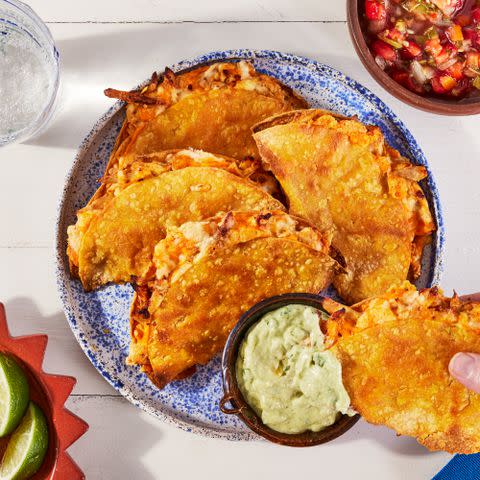
Photographer: Jen Causey
Breakfast (427 calories)
1 serving Tofu Scramble
1 slice whole-wheat bread, toasted, with 1½ tsp. butter, jam or peanut butter
A.M. Snack (131 calories)
1 large pear
Lunch (540 calories)
1 serving Cucumber–Tuna Salad Sandwich
1 medium apple
P.M. Snack (263 calories)
1 medium banana
1½ Tbsp. natural peanut butter
Dinner (636 calories)
1 serving Crispy Chicken Tacos
1 serving Bang Bang Cabbage Slaw
Daily Totals: 1,997 calories, 96g fat, 116g protein, 185g carbohydrate, 34g fiber, 2,161mg sodium
Make it 1,800 calories: Omit toast with butter at breakfast and change A.M. snack to 1 medium orange.
Make it 2,200 calories: Add ¼ cup unsalted dry-roasted almonds to A.M. snack.
Day 2
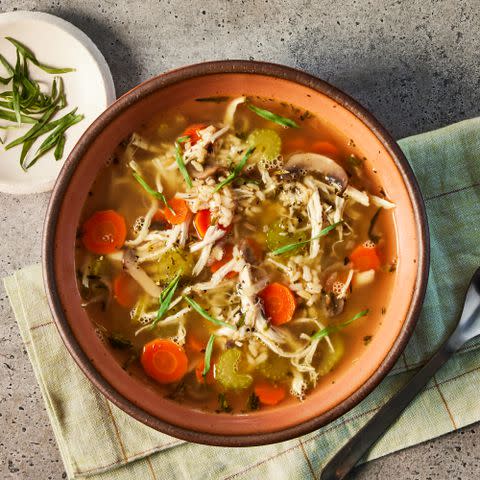
Photographer: Jennifer Causey, Food Stylist: Julian Hensarling, Prop Stylist: Christina Daley
Breakfast (512 calories)
1 serving Sun-Dried Tomato & Feta Egg Bites
A.M. Snack (35 calories)
1 clementine
Lunch (683 calories)
1 serving One-Pot Chicken & Rice Soup
1 medium orange
1 (5.3-oz.) container low-fat plain strained (Greek-style) yogurt
P.M. Snack (248 calories)
1 serving Snickerdoodle Almonds
Dinner (537 calories)
1 serving Balsamic-Butter Salmon Bites
1 serving Garlic-Butter Brussels Sprouts
½ cup cooked brown rice
Daily Totals: 2,015 calories, 91g fat, 116g protein, 198g carbohydrate, 29g fiber, 2,002mg sodium
Make it 1,800 calories: Omit yogurt at lunch and brown rice at dinner.
Make it 2,200 calories: Add 1 ounce dark chocolate and ½ cup raspberries as an evening snack.
Day 3
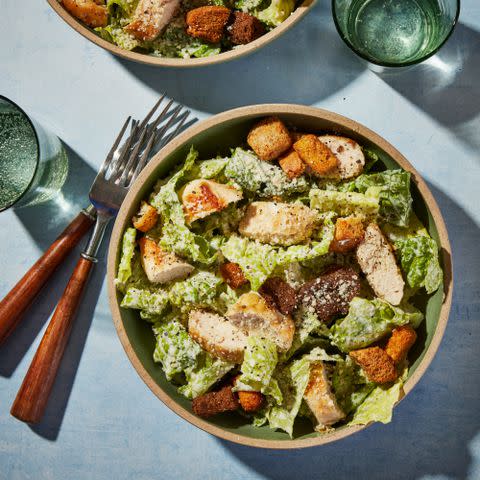
Photographer: Jen Causey, Food Stylist: Julian Hensarling, Prop Stylist: Josh Hoggle
Breakfast (512 calories)
1 serving Sun-Dried Tomato & Feta Egg Bites
A.M. Snack (95 calories)
1 medium apple
Lunch (683 calories)
1 serving One-Pot Chicken & Rice Soup
1 medium orange
1 (5.3-oz.) container low-fat plain strained (Greek-style) yogurt
P.M. Snack (105 calories)
1 medium banana
Dinner (622 calories)
1 serving Chicken Caesar Salad
Daily Totals: 2,017 calories, 87g fat, 116g protein, 209g carbohydrate, 34g fiber, 1,938mg sodium
Make it 1,800 calories: Omit yogurt at lunch and change P.M. snack to ¼ cup blueberries.
Make it 2,200 calories: Add 2 Tbsp. natural peanut butter to the P.M. snack.
Day 4
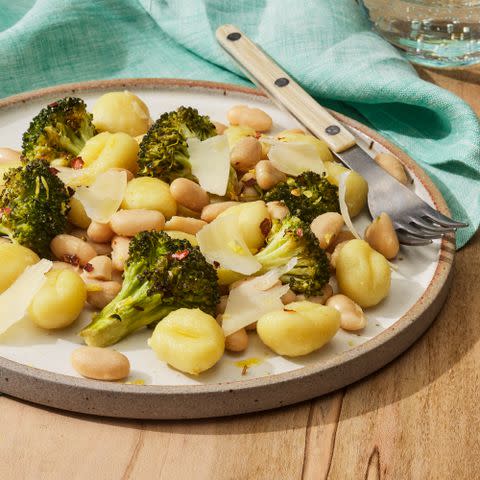
Photographer: Fred Hardy, Food Stylist: Jennifer Wendorf, Prop Stylist: Lydia Pursell
Breakfast (512 calories)
1 serving Sun-Dried Tomato & Feta Egg Bites
A.M. Snack (59 calories)
1 medium peach
Lunch (683 calories)
1 serving One-Pot Chicken & Rice Soup
1 medium orange
1 (5.3-oz.) container low-fat plain strained (Greek-style) yogurt
P.M. Snack (248 calories)
1 serving Snickerdoodle Almonds
Dinner (496 calories)
Daily Totals: 1,997 calories, 94g fat, 95g protein, 208g carbohydrate, 32g fiber, 2,101mg sodium
Make it 1,800 calories: Change A.M. snack to 1 medium apple, omit yogurt at lunch and change P.M. snack to 1 large pear.
Make it 2,200 calories: Add 1 ounce dark chocolate and ½ cup raspberries as an evening snack.
Day 5
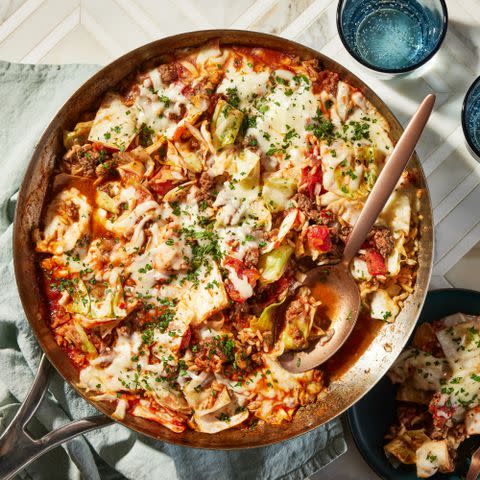
Photographer: Jen Causey, Food Stylist: Julian Hensarling, Prop Stylist: Josh Hoggle
Breakfast (453 calories)
1 serving Apple-Cinnamon Muesli
A.M. Snack (132 calories)
¼ cup hummus
1 cup sliced bell pepper
Lunch (683 calories)
1 serving One-Pot Chicken & Rice Soup
1 medium orange
1 (5.3-oz.) container low-fat plain strained (Greek-style) yogurt
P.M. Snack (248 calories)
1 serving Snickerdoodle Almonds
Dinner (442 calories)
1 serving Unstuffed Cabbage Roll Skillet
2 cups mixed greens + other salad veggies of your choosing, if desired
1 serving Parsley-Lemon Vinaigrette
Evening Snack (59 calories)
1 medium peach
Daily Totals: 2,016 calories, 84g fat, 107g protein, 218g carbohydrate, 36g fiber, 2,227mg sodium
Make it 1,800 calories: Omit hummus at A.M. snack and change P.M. snack to 1 large pear.
Make it 2,200 calories: Add 1 cup low-fat plain kefir to breakfast and a (0.5-oz.) piece of dark chocolate to the evening snack.
Day 6

Photographer: Jennifer Causey, Food Stylist: Julian Hensarling, Prop Stylist: Christina Daley
Breakfast (453 calories)
1 serving Apple-Cinnamon Muesli
A.M. Snack (98 calories)
½ cup low-fat plain strained (Greek-style) yogurt
¼ cup blackberries
Lunch (483 calories)
1 medium banana
P.M. Snack (248 calories)
1 serving Snickerdoodle Almonds
Dinner (561 calories)
Evening Snack (156 calories)
1-oz. piece dark chocolate
Daily Totals: 1,999 calories, 82g fat, 109g protein, 217g carbohydrate, 38g fiber, 1,721mg sodium
Make it 1,800 calories: Change P.M. snack to 1 clementine.
Make it 2,200 calories: Add 1 cup low-fat plain kefir to breakfast and 2 Tbsp. chopped walnuts to A.M. snack.
Day 7
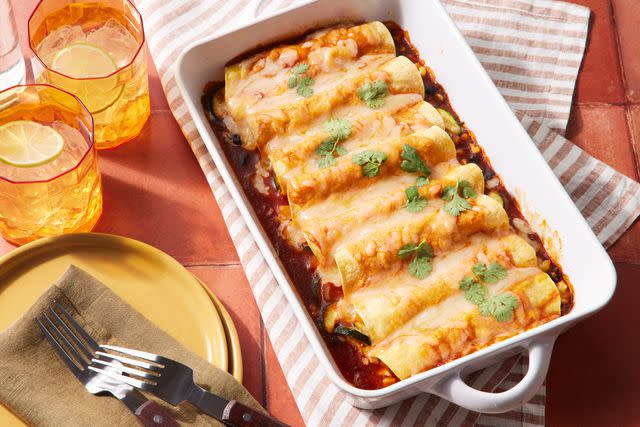
Photographer: Jacob Fox, Food stylist: Holly Dreesman, Prop stylist: Joseph Wanek
Breakfast (453 calories)
1 serving Apple-Cinnamon Muesli
A.M. Snack (215 calories)
1 serving Cottage Cheese Snack Jar with Fruit
Lunch (473 calories)
1 medium apple
P.M. Snack (248 calories)
1 serving Snickerdoodle Almonds
Dinner (473 calories)
1 serving Veggie Enchiladas
¼ cup guacamole
Evening Snack (156 calories)
1-oz. piece dark chocolate
Daily Totals: 2,017 calories, 92g fat, 88g protein, 220g carbohydrate, 42g fiber, 1,912mg sodium
Make it 1,800 calories: Change A.M. snack to ¼ cup blueberries.
Make it 2,200 calories: Add 1 cup low-fat plain kefir to breakfast and add 1 medium peach to the evening snack.
Read the original article on Eating Well.

